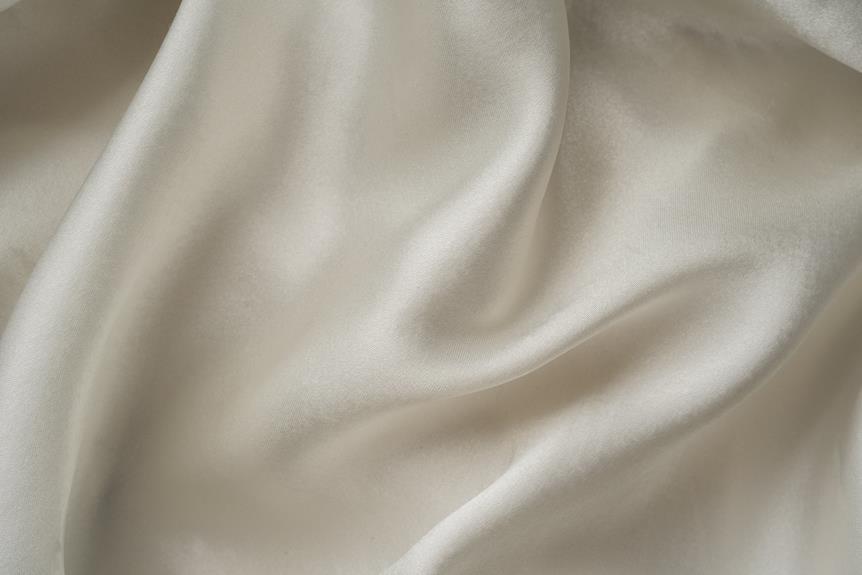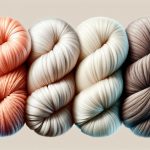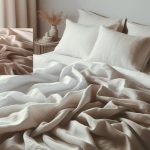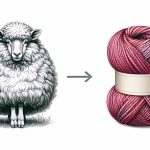If you've heard the adage 'cool as a cucumber,' you know the importance of breathable fabrics. But is silk the most breathable fabric of all?
In this exploration, we'll delve into the science behind fabric breathability and compare silk with other popular materials like cotton, linen, and wool. Understanding the factors that contribute to a fabric's breathability will empower you to make informed choices when it comes to your wardrobe.
So, let's unravel the mystery of silk's breathability and discover whether it truly reigns supreme in the realm of breathable fabrics.
Key Takeaways
- Silk's natural protein structure and smooth surface contribute to its exceptional breathability.
- Silk's ability to regulate temperature and moisture, along with its moisture-wicking properties, make it highly breathable.
- Compared to cotton, silk outperforms in terms of breathability and moisture management.
- While linen also offers good breathability, silk's advanced textile technology enhances its inherent breathability, making it one of the most breathable fabrics.
Understanding Breathability in Fabrics
You may wonder how to measure the breathability of different fabrics and why it matters when choosing clothing. Understanding textile technology and fabric composition is crucial in evaluating the breathability of a fabric. Breathability refers to a fabric's ability to allow air and moisture to pass through, aiding in moisture management and thermal regulation. This is particularly important in performance wear, where comfort and functionality are key. Sustainable fashion also emphasizes the importance of breathability, as it can reduce the environmental impact of clothing production and the overall comfort of the wearer.
Textile technology plays a significant role in enhancing breathability. Innovations in fabric construction and finishes have led to the development of highly breathable materials. By allowing air to circulate and moisture to evaporate, these fabrics offer improved comfort and performance. Understanding the environmental impact of different fabrics is crucial for making sustainable choices. By selecting breathable fabrics, you can contribute to a more environmentally conscious wardrobe while enjoying the benefits of enhanced comfort and functionality.
The Science Behind Silk's Breathability
In evaluating the breathability of silk as a fabric, it's essential to understand its unique properties and how they contribute to its overall performance. Silk possesses remarkable properties that make it highly breathable. These properties include its natural protein structure, smooth surface, and ability to wick away moisture. The science behind silk's breathability lies in these characteristics, which are further enhanced by advanced textile technology.
Silk properties such as its fine, natural protein fibers allow for enhanced breathability. The structure of silk fibers creates tiny pockets of air, which aid in regulating temperature and moisture, making it an ideal fabric for various climates.
Additionally, the smooth surface of silk reduces friction, allowing air to circulate freely, thus enhancing its breathability. This feature also contributes to the fabric's luxurious feel and comfort.
Moreover, silk's ability to wick away moisture efficiently contributes to its breathability. This property enables perspiration to evaporate quickly, keeping the wearer cool and comfortable.
When combined with advanced textile technology, these inherent silk properties make it one of the most breathable fabrics available, offering unparalleled comfort and performance.
Comparing Silk With Cotton
When comparing silk with cotton, you'll find that silk's natural protein structure and smooth surface contribute to its exceptional breathability, setting it apart from cotton as a highly breathable fabric. Silk has the ability to wick away moisture from your body, keeping you dry and comfortable. Let's compare the breathability and moisture management of silk and cotton in the table below:
| Criteria | Silk | Cotton |
|---|---|---|
| Breathability | Natural protein structure and smooth surface allow for excellent airflow and breathability | Less breathable than silk, tends to retain moisture |
| Moisture Management | Wicks moisture away from the body | Absorbs and retains moisture, can feel damp and heavy |
As seen in the table, silk outperforms cotton in both breathability and moisture management. The natural properties of silk make it an ideal choice for maintaining comfort in various climates and activities. While cotton is a popular fabric, especially for daily wear, its breathability and moisture management fall short compared to the exceptional qualities of silk.
Silk Vs. Linen: Which Is More Breathable
Which fabric is more breathable: silk or linen?
When it comes to breathability, both silk and linen have their unique qualities that make them desirable choices. Let's compare silk and linen to determine which fabric offers better breathability.
- Fabric Construction: Silk is a natural protein fiber produced by silkworms, known for its fine texture and luxurious feel. On the other hand, linen is made from the fibers of the flax plant, characterized by its natural luster and cool, crisp hand. The weave and density of the fabric play a significant role in its breathability.
- Breathability Comparison: While both silk and linen are highly breathable, linen is often favored for its exceptional moisture-wicking properties and airflow. The looser weave of linen allows for better air circulation, making it an excellent choice for warm and humid climates.
- Moisture Management: Linen has superior moisture-wicking abilities, quickly absorbing perspiration and releasing it into the air. This quality helps in regulating body temperature and keeping the skin dry. Silk, while breathable, may not manage moisture as effectively as linen.
Exploring the Breathability of Wool
Wool isn't only known for its warmth, but also for its impressive breathability.
When it comes to keeping you comfortable, wool has some distinct advantages.
Its moisture-wicking properties and natural insulation make it a fabric worth considering for a variety of climates and activities.
Wool Breathability Advantages
To understand the breathability advantages of wool, you should consider its unique properties and how they affect comfort and moisture regulation. Wool's natural properties contribute to its breathability, making it an excellent choice for various garments. Here's why wool stands out:
- Moisture Wicking: Wool fibers can absorb moisture vapor from the body and then slowly release it into the air, helping to maintain a dry and comfortable microclimate next to the skin.
- Temperature Regulation: Wool's inherent ability to regulate body temperature makes it suitable for both warm and cool environments, ensuring you stay comfortable throughout the day.
- Odor Resistance: The natural structure of wool fibers resists odors, allowing you to feel fresh even after extended wear.
These unique characteristics make wool a highly breathable and comfortable fabric for everyday use.
Moisture-Wicking Properties of Wool
As you sweat, wool actively draws moisture away from your skin and releases it into the air, keeping you dry and comfortable. This exceptional moisture-wicking property is one of the key benefits of wool fiber.
The structure of wool allows it to absorb a significant amount of moisture vapor without feeling damp, making it an excellent choice for activewear and outdoor clothing. Unlike synthetic fabrics, wool can absorb up to 30% of its weight in moisture without feeling wet, which helps regulate your body temperature and prevents that clammy sensation often experienced with other materials.
By efficiently managing moisture, wool enhances breathability by allowing sweat to evaporate, keeping you feeling fresh and dry during various activities.
Wool's natural moisture-wicking abilities make it a standout choice for anyone seeking comfort and performance in their clothing.
Natural Insulation in Wool
Exploring the breathability of wool, wearing garments made from this natural fiber allows you to stay comfortable in varying temperatures. Wool insulation provides exceptional temperature regulation, making it an ideal choice for both warm and cool environments.
This natural fiber has the remarkable ability to trap air within its fibers, creating an insulating layer that helps to maintain your body's natural warmth while allowing excess heat and moisture to escape. As a result, you experience a consistent level of comfort without feeling overheated or clammy.
Additionally, wool's natural fibers possess a unique structure that enables efficient moisture absorption, keeping you dry and comfortable. Furthermore, wool is naturally breathable, allowing for excellent air circulation to further enhance your comfort.
- Exceptional temperature regulation
- Efficient moisture absorption
- Excellent air circulation
Synthetic Fabrics and Breathability
You can rely on synthetic fabrics for breathability during physical activities, but not all synthetic fabrics are equally breathable.
Synthetic materials, such as polyester and nylon, are engineered to wick moisture away from the body, allowing it to evaporate quickly. The fabric composition of synthetic materials plays a crucial role in their breathability, with moisture retention being minimized to keep you dry and comfortable during workouts or outdoor adventures.
Additionally, some synthetic fabrics are designed with advanced thermal regulation properties, ensuring that your body temperature stays balanced as you exert yourself.
When choosing synthetic activewear, look for garments that are specifically labeled as breathable or moisture-wicking to ensure optimal performance. Keep in mind that the breathability of synthetic fabrics can vary based on the specific composition and quality of the material.
Understanding the characteristics of different synthetic fabrics will empower you to make informed choices when selecting activewear that offers superior breathability for your active lifestyle.
Factors Affecting Fabric Breathability
When it comes to fabric breathability, several factors play a crucial role in determining how well a material allows air and moisture to pass through.
The type of fiber used, the weave of the fabric, and its thickness all contribute to its breathability.
Understanding these factors can help you make informed choices when selecting fabrics for different purposes, whether it's for athletic wear, everyday clothing, or bedding.
Fiber Type Impact
Silk is known for being incredibly breathable due to its unique fiber structure and natural properties. When comparing different fiber types, it's essential to consider their impact on fabric breathability.
Factors such as fiber shape, size, and arrangement play a crucial role in determining how breathable a fabric is. Here are some key elements to consider when analyzing the impact of fiber types on fabric breathability:
- Fiber structure: The structure of the fibers, whether natural or synthetic, significantly affects how well air can flow through the fabric.
- Moisture absorption: Different fiber types have varying abilities to absorb and wick moisture away from the body, impacting overall breathability.
- Surface texture: The surface texture of fibers can affect how air circulates through the fabric, influencing its breathability.
Understanding the impact of fiber types on fabric breathability can help you make informed decisions when choosing the most breathable fabrics for your needs.
Weave and Thickness
Fabric weave and thickness significantly impact breathability, affecting how well air circulates through the material and how easily heat and moisture can escape. Weave tightness refers to how closely the threads are woven together, while fabric density relates to the weight of the material. These factors play a crucial role in determining the breathability of a fabric. A tighter weave restricts airflow, reducing breathability, whereas a looser weave allows for better air circulation. Similarly, thinner fabrics generally offer improved breathability compared to thicker ones, as they allow for more efficient air and moisture permeability. To better understand the impact of weave and thickness on breathability, consider the following table:
| Weave Tightness | Fabric Density | Breathability |
|---|---|---|
| Tight | High | Low |
| Loose | Low | High |
Understanding these factors can empower you to make informed choices when selecting fabrics for different purposes.
Frequently Asked Questions
Can Silk Be Considered a Sustainable and Eco-Friendly Fabric in Addition to Being Breathable?
When considering sustainable silk, it's essential to understand its impact on the environment. Eco-friendly fabric choices can make a significant difference. Silk production, when done responsibly, can contribute to a more sustainable and eco-friendly fashion industry.
Are There Any Potential Downsides to Silk's Breathability, Such as Its Ability to Retain Moisture?
Considering potential downsides, silk's moisture retention can be a concern when compared to other breathable fabrics. However, advancements in sustainable silk production and eco-friendly practices make it a compelling choice despite this drawback.
How Does the Breathability of Silk Compare to Other Natural Fabrics Like Bamboo or Hemp?
When comparing the breathability of silk to linen, it's important to note that silk's natural properties make it exceptionally breathable, allowing for better moisture absorption and evaporation. This sets it apart from other natural fabrics, such as bamboo or hemp.
Are There Specific Types of Silk, Such as Mulberry Silk or Wild Silk, That Offer Different Levels of Breathability?
When it comes to silk, different types like mulberry and wild silk can offer varying levels of breathability due to differences in weaving techniques and finishes. This makes silk a sustainable, moisture-wicking, and eco-friendly fabric compared to bamboo or hemp.
Can the Breathability of Silk Be Affected by Different Weaving Techniques or Finishes, Such as Satin or Charmeuse?
Weaving techniques and finishes like satin or charmeuse can affect silk's breathability. Satin finish may reduce breathability while charmeuse weaving enhances it. Silk has better moisture retention compared to bamboo, making it a top choice for breathability.
- How Does Ring Spun Cotton Affect Garment Fit and Shape Retention? - August 13, 2024
- What Are the Challenges in Producing Ring Spun Cotton? - August 13, 2024
- Is Ring Spun Cotton Suitable for Plus-Size Clothing? - August 13, 2024






